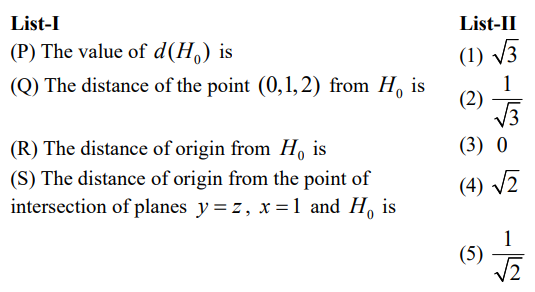Let l1 and l2 be the lines →r1=γ(ˆi+ˆj+ˆk) and →r2=(ˆj−ˆk)+μ(ˆi+ˆk), respectively. Let X be the set of all the planes H that contain the line l1 .For a plan H ,let d (H) denote the smallest possible distance between the points of l2 and H . Let H0 be a plane in X for which d(H0) is the maximum value of d H( ) as H varies over all planes in X .
Match each entry in List-I to the correct entries in List-II.

The correct option is:
(P)→(2)(Q)→(4)(R)→(5)(S)→(1)
(P)→(5)(Q)→(4)(R)→(3)(S)→(1)
(P)→(2)(Q)→(1)(R)→(3)(S)→(2)
(P)→(5)(Q)→(1)(R)→(4)(S)→(2)
Step by step video solution for Let l_1 and l_2 be the lines vec r_1= gamma (hati+ hatj +hat k ) and vecr_2 = (hatj -hat k) +mu(hati+hat k ), respectively. Let X be the set of all the planes H that contain the line l_1 .For a plan H ,let d (H) denote the smallest possible distance between the points of l_2 and H . Let H_0 be a plane in X for which d(H_0) is the maximum value of d H( ) as H varies over all planes in X . Match each entry in List-I to the correct entries in List-II. The correct option is: by Maths experts to help you in doubts & scoring excellent marks in Class 12 exams.
Updated on:21/07/2023Topper's Solved these Questions
Similar Questions
Let l1 and l2 be the lines →r1=γ(ˆi+ˆj+ˆk) and →r2=(ˆj−ˆk)+μ(ˆi+ˆk), respectively. Let X be the set of all the planes H that contain the line l1 .For a plan H ,let d (H) denote the smallest possible distance between the points of l2 and H . Let H0 be a plane in X for which d(H0) is the maximum value of d H( ) as H varies over all planes in X .
Match each entry in List-I to the correct entries in List-II.

The correct option is:
View SolutionLet L1 be the line →r1=2ˆi+ˆj−ˆk+λ(i+2ˆk) and let L2 be the line →r2=3ˆi+ˆj+μ(i+ˆj−ˆk) . Let π be the plane which contains the line L1 and is parallel to L2. The distance of the plane π from the origin is a. √6 b. 1/7 c. √2/7 d. none of these
View Solution
Knowledge Check
Let L1 be the line →r1=2ˆi+ˆj−ˆk+λ(ˆi+2ˆk) and let L2 be the line →r2=3ˆi+ˆj−ˆk+μ(ˆi+ˆj+ˆk). Let π be the plane which contains the line L1 and is parallel to L2. The distance of the plane π from the origin is
A√2/7B1/7C√6DnoneIf →a=ˆi+2ˆj+2ˆkand→b=3ˆi+6ˆj+2ˆk then the vector in the direction of →a and having mgnitude as ∣∣→b∣∣ is
A7(ˆi+2ˆj+2ˆk)B79(ˆi+2ˆj+2ˆk)C73(ˆi+2ˆj+2ˆk)Dnone of theseLet L1 be the line r1=2ˆi+ˆj−ˆk+λ(ˆi+2ˆk) and let L2 be the another line r2=3ˆi+ˆj+μ(ˆi+ˆj−ˆk). Let ϕ be the plane which contains the line L1 and is parallel to the L2. The distance of the planeϕ from the origin is
A√27B17C√6DNone of these
Consider two lines in space as L1:→r1=ˆj+2ˆk+λ(3ˆi−ˆj−ˆk) and L2:→r2=4ˆi+3ˆj+6ˆk+μ(ˆi+2ˆk). If the shortest distance between these lines is √d then d equals
View SolutionFind whether the lines :
→r=(ˆi−ˆj−ˆk)+λ(2ˆi+ˆj)
→r=(2ˆi−ˆj)+μ(ˆi+ˆj−ˆk)
intersect or not. If intersecting, Find their point of intersection.
View SolutionLet L be the set of all straight lines in the Euclidean plane. Two line l1 and l2 are said to be related by the relationR of l1 is parallel to l2, Then R is
View SolutionLet →a=ˆi−2ˆj+3ˆk,→b=3ˆi+3ˆj−ˆkand→c=dˆi+ˆj+(2d−1)ˆk. If →c is parallel to the plane of the vectors →aand→b, then 11d=
View SolutionLet →a=ˆi−ˆk,→b=xˆi+ˆj+(1−x)ˆkand→c=yˆI+xˆj+(1+x−y)ˆk. Then [→a,→b,→c] depends on
View Solution
